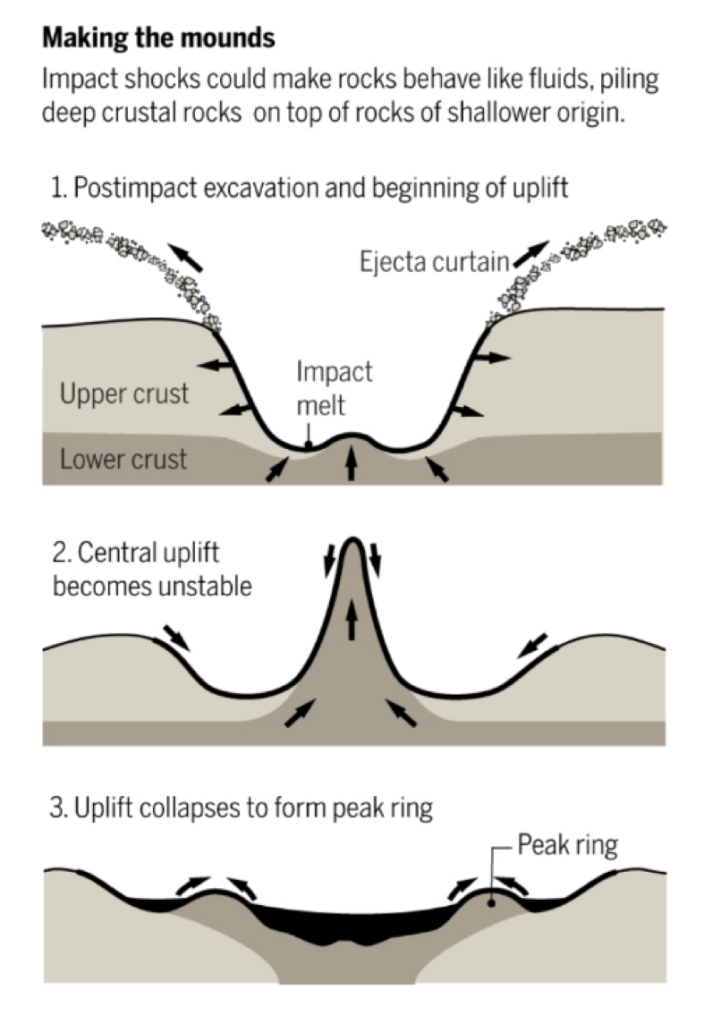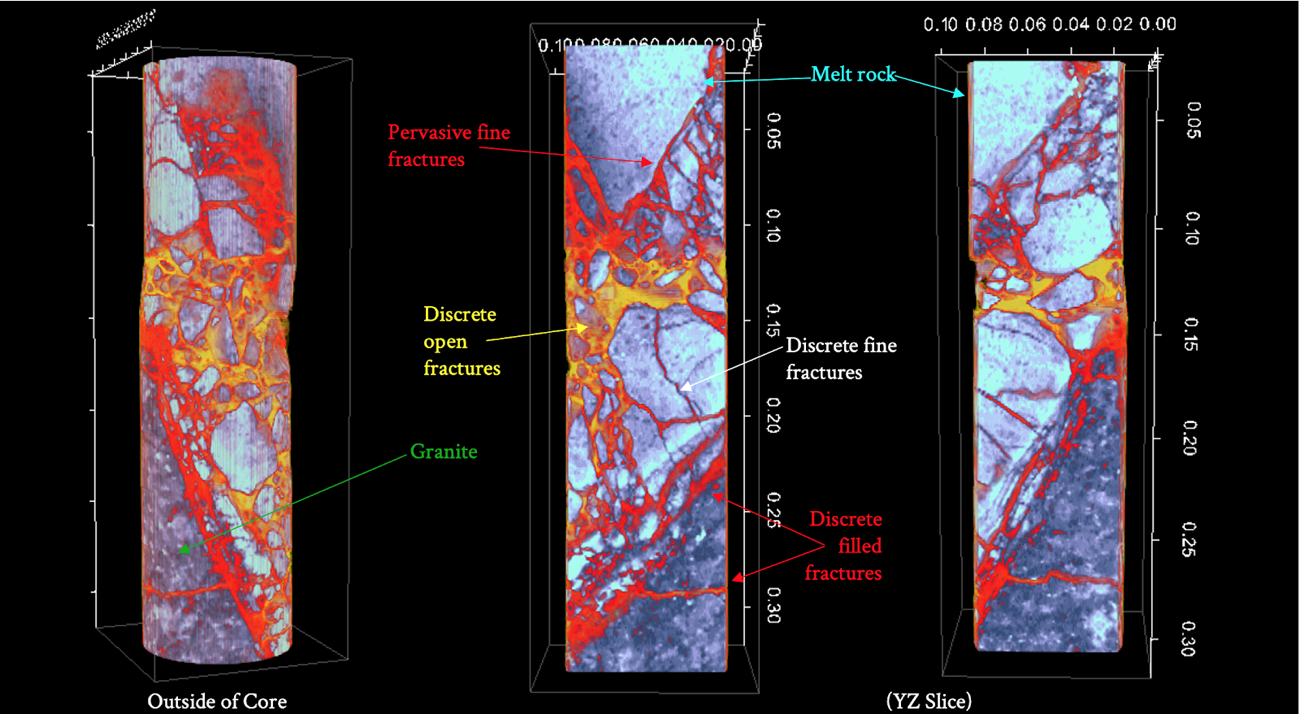Author: Brendon Hall PhD., Director Energy Solutions
In 2016, a joint IOPD-ICDP Expedition no. 364 (International Ocean Discovery Program and International Continental Scientific Drilling Program) collected core samples from the peak ring of the Chicxulub crater. The impact crater was formed 66 million years ago when an estimated 15-kilometer diameter asteroid’s impact triggered a series of catastrophic events that ended the Cretaceous era and contributed to – if not outright caused – the mass extinction of dinosaurs.
In September 2019, the Proceedings of the National Academy of Sciences (PNAS) published a research article ‘The First Day of the Cenozoic’, where I was fortunate to be an author contributor. The timing of the research article was based on completion of the analysis of core taken through the peak ring, providing unprecedented insight into the first minutes and day after the impact (https://www.pnas.org/content/116/39/19342 ). I provided visualization and image analysis applying machine learning techniques using software developed by Enthought for analysis of oil well cores. The publication off the PNAS research article prompted a number of articles on the topic, some cited here.
Other projects have collected geological samples from the interior of the Chicxulub crater. However, Expedition 364 was the first to collect core samples from the peak ring. The samples were then subjected to CT scans and assembled into “virtual” cores. This allowed image analysis and visualization by science researchers without access to the physical cores.
Image Analysis and Visualization of Core Samples Used by Geologists, Climatologists, and Biologists
The Chicxulub crater was studied not just for its historical significance as the “dinosaur asteroid.” Chicxulub is also the only impact crater on Earth with an intact peak ring. Expedition 364 aimed to study the geology of the peak ring for what it could tell scientists about asteroid impacts and crater formation. They also analyzed the sediment layers that overlay the peak ring for insight into the aftereffects of the asteroid impact on the climate and life.
The Hypothesis for the Sequence of Events Upon Impact and the Following Hours
When the asteroid struck, the impact created a hole about 100 kilometers across and 30 kilometers deep as the force sent material kilometers into the air. Subsequent geologic processes left a present-day crater 150 kilometers wide and 20 kilometers deep. The “peak ring” structure of the crater was then covered by approximately 40 meters of impact melt and breccia, a testament to the extremely high temperatures capable of melting rock. An additional 21 meters of melted rock covered the rings. At the same time, the impact displaced a tremendous volume of ocean water, which rolled outward from the crater as an enormous tsunami over a hundred meters high.
Over the next 24 hours, larger, heavier pieces of rock fell back to Earth, with smaller, lighter pieces of debris landing on top of those. This example of size-sorting has been found across North America, with the rocks dating to the Chicxulub impact. At the crater, a gap in the ring structure allowed water to flood back into it, along with nearly 90 meters of melted rock.
The intense heat from the impact raised temperatures over a wide area; it would have been felt more than 1,500 kilometers away. The combination of that thermal energy and the high temperatures of the rocks that continued to rain back down onto the earth’s surface triggered massive wildfires in the days after impact. As fires burned across entire continents, waves continued to wash up on shorelines and began to collect the charcoal generated from the fires.
The center of the impact rebounded, pushing a wave of shocked granite up from the impact site. The wave collapsed into the impact site and propagated outward toward the crater rim.
Simultaneously, rock pushed outward by the asteroid impact used up its kinetic energy building the crater rim. Some of the rock forming the crater rim rolled back into the impact site under the influence of gravity. The outward wave from the impact site and inward wave from the crater rim combined to form the peak ring.

The core confirmed that the peak ring was formed from basement rock deep in the subsurface. Source: Sciencemag.org
Collecting Core Samples to Study the Hypothesis of Peak Ring Formation
Craters observed from the moon include concentric rings. However, every known crater on Earth, except the Chicxulub crater, includes only a crater rim (the outermost ring). Initial analysis of the core’s features suggested that the hypothesis regarding how the crater’s “peak ring” structure formed—that a single over-heightened central peak collapsed into the multiple-peak-ring structure—was accurate.
The crater rim and the peak ring (the first inner ring) of the Chicxulub impact crater are visible from satellite photographs. The peak ring of the Chicxulub crater is submerged under about 600 meters of ocean sediment and has thus been preserved intact.
Approximately 829 meters of core was collected from the peak ring and CT imaged, a technique common in oil exploration. The scans provided cross-sectional images of the cores which were visualized and analyzed by Enthought scientist Brendon Hall using their Virtual Core application.

A digital model of the a section of the Chicxulub core created using Enthought’s Virtual Core application.
The CT data were assembled into three-dimensional (3D) models of the cores. Image analysis of the cross-sections and 3D models allowed scientists to study the core samples non-destructively. This preserved the cores for future generations of scientists.
The CT scans also collected density and atomic number data of the rock samples. These data were used to color code the images, providing a visualization of the material distribution patterns in the cores.
The data from the cores showed that the peak ring contained substantial amounts of shocked granite. Granite is usually not found in the earth’s upper crust. Rather, it is found in the lower crust, around eight kilometers beneath the earth’s surface. Moreover, the granite from the cores was unusual. As explained by the scientists involved in the drilling, this granite was weaker and lighter than usual and crumbled in their hands.
The core samples confirmed the hypothesis that the asteroid drove deep into the earth’s crust, pushing the upper crust laterally to form the crater’s rim. The impact energy compressed and melted granite in the lower crust directly below the impact site.
Analysis of Sediments Confirmed a Tsunami and Change in Climate
The sediment that lay on top of the peak ring and granite was also analyzed and contained less gypsum (calcium sulfate) than expected. This supported the theory that the impact created the conditions for a massive climate shift that resulted in broad extinctions.
Under this theory, the impact was violent and hot enough to vaporize calcium sulfate, hence the lack of gypsum in the core samples. This would have created a thick cloud of sulfur dioxide. The sulfur dioxide cloud combined with dust produced by the impact and smoke from wildfires to reduce the amount of sunlight reaching the earth’s surface. This dense layer in the atmosphere caused the air temperature to drop near freezing for several years.
The initial atmospheric cooling was followed by an extreme greenhouse effect lasting about 100,000 years. This global warming of about five degrees Celsius resulted from carbon dioxide and water vapor produced by the impact.
Analysis of the core samples revealed a layer of deposits tens of meters deep. The sedimentary deposits were size-sorted and contained markers associated with soil. This confirmed that they were deposited immediately after impact by rock raining down on the impact site and a tsunami that dragged soil to the crater from coastlines. Enthought collaborated with Chicxulub scientists to build a machine learning model to study the distribution of rock fragments in this section, which was used to help reconstruct the events of the first day of the Cenozoic.
Fossils in the Core Samples Told the Story of Recovery
Before Expedition 364, biologists theorized that hydrothermal vents opened by the asteroid impact might have facilitated the repopulation of the Chicxulub crater by extremophiles. However, analysis of the core samples found that this theory was incomplete. Rather, the area was largely repopulated by ordinary plankton, with extremophiles playing a much smaller role than hypothesized.
In fact, fossils found in the sediment records showed that ocean life had recovered at the impact site 30,000 years after impact. This means recovery in the impact zone was faster than recovery in some locations farther from the impact site.
Thus, the core samples not only told the story of the destruction caused by the asteroid impact but also the story of the recovery afterward.
To learn more about how Enthought’s domain knowledge and computational-software expertise support science researchers, contact Enthought.
About the Author
Brendon Hall PhD., Director Energy Solutions holds a Ph.D. in mechanical engineering from the University of California Santa Barbara, and a B.Eng. in mechanical engineering as well as B.Sc. in computer science from Western University in Canada.
Related Content
Reshaping Materials R&D: Navigating Margin Pressure in the Specialty Chemicals Industry
The era of the AI Co-Scientist is here. How is your organization preparing?
The Emergence of the AI Co-Scientist
The era of the AI Co-Scientist is here. How is your organization preparing?
Understanding Surrogate Models in Scientific R&D
Surrogate models are reshaping R&D by making research faster, more cost-effective, and more sustainable.
R&D Innovation in 2025
As we step into 2025, R&D organizations are bracing for another year of rapid-pace, transformative shifts.
Revolutionizing Materials R&D with “AI Supermodels”
Learn how AI Supermodels are allowing for faster, more accurate predictions with far fewer data points.
What to Look for in a Technology Partner for R&D
In today’s competitive R&D landscape, selecting the right technology partner is one of the most critical decisions your organization can make.
Digital Transformation vs. Digital Enhancement: A Starting Decision Framework for Technology Initiatives in R&D
Leveraging advanced technology like generative AI through digital transformation (not digital enhancement) is how to get the biggest returns in scientific R&D.
Digital Transformation in Practice
There is much more to digital transformation than technology, and a holistic strategy is crucial for the journey.
Leveraging AI for More Efficient Research in BioPharma
In the rapidly-evolving landscape of drug discovery and development, traditional approaches to R&D in biopharma are no longer sufficient. Artificial intelligence (AI) continues to be a...
Utilizing LLMs Today in Industrial Materials and Chemical R&D
Leveraging large language models (LLMs) in materials science and chemical R&D isn't just a speculative venture for some AI future. There are two primary use...